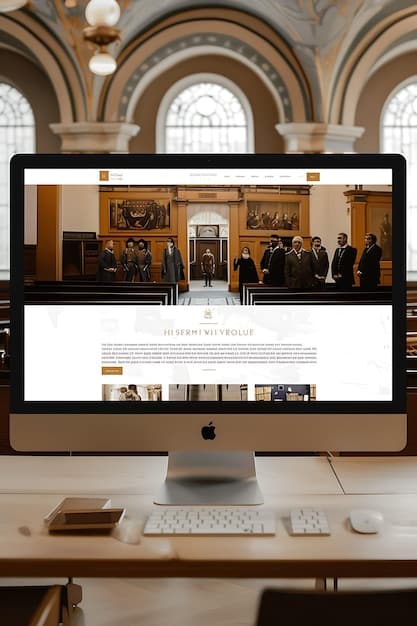How to Interpret Congressional Records: A Comprehensive Guide

Interpreting congressional records involves understanding the legislative history, which includes bills, amendments, committee reports, and debates, to discern the intent and meaning behind laws enacted by the U.S. Congress.
Navigating the maze of **how to interpret congressional records: a guide to understanding legislative history** can be daunting, but it’s crucial for grasping the intent behind laws. This article breaks down the key components and techniques for effective interpretation.
Understanding the Nature of Congressional Records
Congressional records are the official documentation of the United States Congress’s activities. They provide a comprehensive account of the legislative process, which is essential for anyone seeking to understand the genesis and intent of federal laws.
These records include a variety of documents, each offering unique insights into the legislative process.
Types of Congressional Records
Several types of documents make up the bulk of congressional records, each offering a different perspective on the legislative process.
- Bills and Resolutions: These are the proposed laws and formal expressions of opinion that Congress considers.
- Committee Reports: These reports summarize a committee’s findings and recommendations on a bill.
- Congressional Hearings: Transcripts of testimonies and discussions on proposed legislation.
- Debates: The official record of discussions and arguments made on the floor of the House and Senate.
These documents collectively provide a rich source of information for understanding the intentions and context of laws.
In conclusion, understanding the types of Congressional Records is foundational for anyone seeking to interpret legislative intent and trace the development of federal laws.
Locating and Accessing Congressional Records
Finding the right congressional records can seem like a daunting task, but with the right resources and strategies, it’s entirely manageable. This section outlines the key resources and platforms for accessing these vital documents.
Accessing these records correctly will help you deepen your understanding of legislative history. Mastering these resources will greatly assist in your research.

Key Resources for Congressional Records
Several institutions and online databases offer access to congressional records, each with its own strengths and features.
- The Library of Congress: A comprehensive repository of legislative materials.
- GovInfo: A service of the U.S. Government Publishing Office (GPO) that provides access to official publications.
- ProQuest Congressional: A subscription service offering streamlined access to a vast collection of legislative documents.
- HeinOnline: A database specializing in legal and historical documents, including legislative histories.
Utilizing these resources effectively is key to conducting thorough research on congressional records.
In conclusion, by leveraging these key resources and refining your search strategies, you can effectively locate and access the congressional records necessary for your research.
Reading and Understanding Bills and Resolutions
Bills and resolutions are the backbone of congressional activity, representing proposed laws and formal expressions of opinion. Learning to dissect these documents is crucial for understanding the legislative process.
Bills and Resolutions have many parts, but understanding how the are written is essential to understanding how they need to be read and interpreted.
Key Components of Bills and Resolutions
Familiarize yourself with the structure and key sections of these documents to grasp their intent and impact.
- Title: A brief summary of the bill’s subject.
- Sponsor(s): The member(s) of Congress who introduced the bill.
- Statement of Purpose: A section outlining the bill’s intent and objectives.
- Amendments: Proposed changes to the original text of the bill.
Understanding these components helps you track the progress and evolution of legislation.

In conclusion, carefully examining the key components of bills and resolutions allows for a deeper understanding of the legislative proposals and their potential impact on law and policy.
Deciphering Committee Reports
Committee reports are crucial documents that summarize a committee’s findings and recommendations on a bill. They offer valuable insights into the reasoning and justification behind legislative proposals.
They are prepared by congressional committees, and delving into these reports provides invaluable context and analysis of legislation.
The Significance of Committee Reports
These reports serve as a window into the legislative process, offering explanations and justifications for the decisions made by committees.
Committee reports often include:
- Summary of the Bill: An overview of the bill’s main provisions.
- Background and Purpose: Contextual information and reasons for the legislation.
- Section-by-Section Analysis: A detailed explanation of each section of the bill.
- Views of Dissenting Members: Alternative opinions and arguments against the bill.
These elements provide a comprehensive understanding of the bill’s intent and potential impact. Carefully analyzing these elements is key to understanding the legislative intent.
In conclusion, dissecting committee reports provides a comprehensive understanding of the rationale and potential impact of proposed legislation, allowing for a more informed interpretation of congressional records.
Analyzing Congressional Hearings
Congressional hearings are sessions where committees gather information and perspectives on proposed legislation. Analyzing these hearings provides insight into the debates, concerns, and expertise that shaped the final law.
By understanding the hearings, you can gain a valuable understanding of the legislative discussions and viewpoints.
Key Aspects of Congressional Hearings
Focus on the testimonies, discussions, and expert opinions presented during the hearings to understand the nuances of the legislative debate.
- Witness Testimonies: Statements from experts, stakeholders, and members of the public.
- Committee Discussions: Questions and debates among committee members.
- Supporting Documents: Evidence and data presented to support arguments.
A thorough analysis of these factors can significantly enhance your understanding of the legislative process.
In conclusion, a deep dive into congressional hearings provides invaluable context and a nuanced understanding of the issues debated, ultimately enriching your interpretation of congressional records.
Following Congressional Debates
Congressional debates are the formal discussions and arguments conducted on the floor of the House and Senate. They offer a real-time view of the legislative process, showcasing the diverse perspectives and political considerations at play.
Following congressional debates is a great way to get to know the in’s and out’s of processes to pass certain Bill’s. Understanding these debates is crucial to get a more holistic understanding.
Strategies for Analyzing Congressional Debates
To effectively analyze congressional debates, it’s important to identify the key arguments, understand the political context, and recognize the rhetorical strategies used by lawmakers.
- Identify Key Arguments: Pinpoint the main points of contention and support.
- Understand the Political Context: Consider the political climate and motivations of the speakers.
- Recognize Rhetorical Strategies: Identify persuasive techniques used by lawmakers.
By employing these tactics, you can gain a more comprehensive understanding of the positions and motivations of those involved.
In conclusion, closely following and analyzing congressional debates is essential for grasping the real-time dynamics, diverse perspectives, and political considerations that shape legislation.
| Key Point | Brief Description |
|---|---|
| 📜 Types of Records | Bills, committee reports, and hearings provide insights. |
| 🏛️ Key Resources | Library of Congress, GovInfo, ProQuest are essential. |
| 🔍 Analyzing Bills | Focus on sponsors, purpose, and amendments. |
| 🗣️ Debates | Understand arguments, context, and rhetoric. |
Frequently Asked Questions
▼
Key components include bills, committee reports, congressional hearings, and floor debates, which together document the legislative process and intentions of Congress.
▼
You can access congressional records through resources like the Library of Congress, GovInfo, ProQuest Congressional, and HeinOnline, each offering unique collections and search capabilities.
▼
Focus on the title, sponsors, statement of purpose, and any amendments to understand the legislation’s intent and evolution through the legislative process.
▼
Committee reports provide summaries, backgrounds, and section-by-section analyses of bills, offering insights into the committee’s reasoning and justification for legislative proposals.
▼
Analyzing hearings provides valuable context by revealing testimonies, discussions, and expert opinions that shape the final law, enabling a more informed interpretation of congressional records.
Conclusion
Understanding **how to interpret congressional records: a guide to understanding legislative history** is essential for comprehending the intent and context behind federal laws. By exploring the different types of records, utilizing key resources, and employing effective analysis strategies, you can gain valuable insights into the legislative process and the legal framework of the United States.





